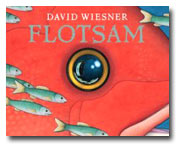Books |
Flotsam
David Wiesner
By
Published: May 20, 2009
Category:
Children
When the child was “four-and-a-half-and-three-quarters-but-in-my-head-I’m-seven,” boy, was she ready to read. Signs, newspaper headlines, the crawl on Fox News — kidding about Fox News — captivated her.
We were delighted. And we wanted to encourage her. (Which did not extend to teaching her how to read; we are old, our reservoir of patience is not what it once was, it’s better to let the experts at her high-priced school do the job.) So we got her the picture books of David Wiesner and asked her to tell us the story.
Wiesner is the acknowledged master of wordless books for kids. (All three of the Wiesner books we own — Tuesday, The Three Pigs and Flotsam, his most recent book — have won the Caldecott Medal.) It’s not just that he draws beautifully and that his pictures allow a child aged 4 through 7 to tell the story. His greater gift is his refusal to talk down. His books are challenging. They are invitations to consider the story later, to broaden a child’s sense of the world — or, more accurately, they reflect the ability of most children to dream big and think poetically.
“Flotsam,” for example, takes us to the beach. A well-equipped boy — he’s got a magnifying glass, binoculars and a microscope — is digging and exploring while his parents read. He’s so fascinated by a crab he doesn’t see a rogue wave rolling in; when it rolls out, there’s an ancient box camera at his feet. He shows it to friends, who are predictably puzzled. (Film inside? What, no digital chip?) And he takes the film to be developed at a one-hour photo shop.
Back at the beach, the boy looks at the pictures. One is of fish — but some of the fish have gears. In another, sea creatures sit on lounge chairs in an underwater living room. A puffer becomes a hot air balloon. A village of shells travels on the back of a turtle. Aliens have a party on an underwater terrace. Giant starfish walk in the shallows.
And then there is the picture of a Japanese girl. She’s holding a picture of another kid, who’s holding a picture of another kid, who’s holding….The magnifying glass isn’t powerful enough; this is a job for the microscope.
And now, as we look deeper into the pictures, we are moving back into time. The decades fly by — we end in the late 19th century, looking at a boy on the beach. Which gives our inquisitive lad an idea: He’ll take a self-portrait using this old camera.
As soon as he snaps the shutter, he’s hit by another wave. The photos scatter. The boy thinks for a moment, then throws the camera into the water. We see it float in the moonlight. Get pulled by a squid. Become a carriage for sea horses. Fly in the bill of a pelican. Float on an iceberg. And, at last, wash up on a beach.
A little girl, sitting on the beach, sees the camera. She reaches for it….
That’s only half the story. The lesser half, really. The much larger part begins with your kid saying, “I want to read that book.” And then, in her little voice, she tells you a story.
To buy “Flotsam” from Amazon.com, click here.
To buy “Tuesday” from Amazon.com, click here.
To buy “The Three Pigs” from Amazon.com, click here.


